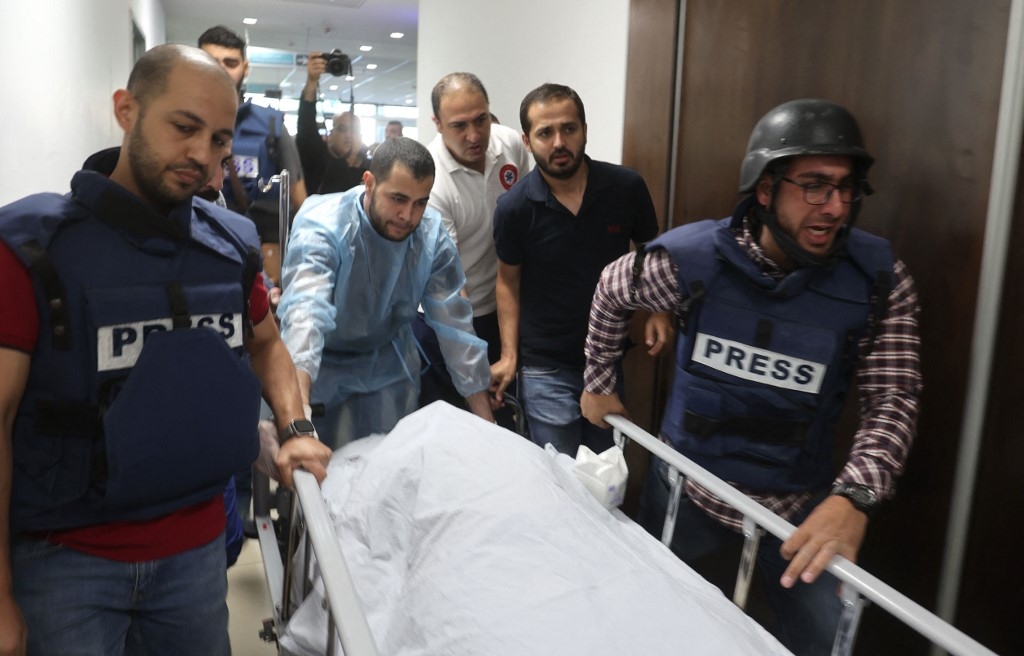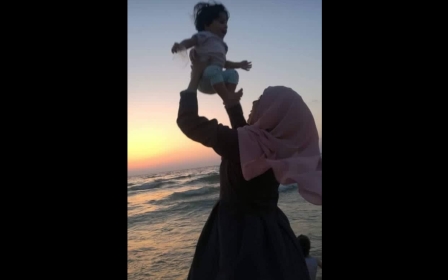Shireen Abu Akleh killing: Israel's record of killing Palestinian journalists

Shireen Abu Akleh, who was shot and killed by an Israeli sniper on Wednesday as she arrived to cover a dawn raid in the West Bank city of Jenin, is the latest in a long list of Palestinian reporters killed by Israeli forces.
Israel has for decades been documented killing and maiming journalists.
In April, a formal complaint was filed with the International Criminal Court (ICC), alleging that Israel’s “systematic targeting” of Palestinian journalists and its failure to investigate their killings amounted to war crimes.
Israeli authorities have led an unprecedented crackdown on local journalists attempting to cover violent developments on the ground since the outbreak of Palestinian protests in East Jerusalem, the West Bank, and across Israel in May 2021.
Police and armed forces have beaten and fired live ammunition on journalists covering the unfolding of events, particularly following attacks on al-Aqsa Mosque and Israel's deadly bombardment of Gaza.
New MEE newsletter: Jerusalem Dispatch
Sign up to get the latest insights and analysis on Israel-Palestine, alongside Turkey Unpacked and other MEE newsletters
In the West Bank, photojournalists were targeted with steel bullets while doing their job at the northern entrance to the city of al-Bireh, near the settlement of Beit El, Middle East Eye reported last year.
Israeli police were also seen intimidating members of the press covering the events, as well as disrupting reports and footage coming from the ground.
Additionally, Israeli airstrikes on Gaza destroyed al-Jalaa Tower last year, which housed a number of media offices used by outlets including Middle East Eye, Al Jazeera, the Associated Press, and other local media organisations.
The Israeli airforce also destroyed al-Shorouk Tower, which housed seven media outlets; and al-Jawhara tower, which houses the offices of over a dozen media organisations, including the Palestine Newspaper, Al Kufiya Channel, Bawaba 24, and the Palestinian Media Forum.
Palestinian news agency Wafa has a list of dozens of journalists killed since 1972, with the tally increasing significantly since the start of Second Intifada in 2000.
Palestinian journalists were targeted while covering the Israeli assaults on the West Bank cities in 2002, while during the summer of 2014, Israeli killed 17 Palestinian journalists during its war on Gaza Strip.
Both the UN and the Committee to Protect Journalists have documented 17 Palestinian journalists being killed since 2000. This does not include Abu Akleh or several journalists killed from other countries: two Italians, one Turk, and one Welshman.
The Palestinian Journalists Syndicate, however, says the number is far higher. In 2020, the group said that Israeli forces had killed more than 46 Palestinian journalists since the Second Intifada in 2000.
"The Syndicate counts annually between 500 and 700 [Israeli] occupation attacks and crimes against Palestinian journalists and it's time for these crimes to stop and to hold accountable those who committed them and those who issued the orders," Tahseen al-Astal, the deputy head of the syndicate, told Anadolu Agency at the time.
He added that Israel’s "aim [is] to silence and prevent the factual press image from being conveyed to the world."
The journalists killed by Israeli fire or airstrike since 2000 include the following:
1- Aziz Yousef al-Tineh, 32, of Wafa news agency, was shot by Israeli forces near Bethlehem on 28 October 2000.
2- Othman Abdul Qader al-Qatnani, 24, from Askar refugee camp in Nablus, was killed in an Israeli airstrike on 31 July 2001. He was a reporter for the Kuwaiti Kona news agency, working at the Nablus Press office.
3- Muhammad Abdul-Karim al-Bishawi, 27, from Nablus, a photojournalist at an-Najah Journalism Center, was killed in an Israeli airstrike on 31 July 2001.
4- Ahmed Numaan, 38, the manager of Bethlehem TV, was killed during an Israeli assault on the city of Bethlehem on 8 March 2002.
5- Raffaele Ciriello, 42, an Italian veteran journalist who covered conflicts in Afghanistan and Kosovo, was shot by Israeli fire near the Manara Square in Ramallah during fierce gunbattles between Israeli soldiers and Palestinian militants on 11 March 2002. He reported for Corriere della Sera.
6- Jamil Abdullah al-Nawawra, 35, from Bethlehem, died on 14 March 2002 from a wound he received by shrapnel from an artillery shell fired by an Israeli tank during an assault on Ramallah. He worked for Palestine TV.
7- Amjad Bahjat al-Alami, 22, a cameraman working for Palestine TV and Al Nawras TV, was shot by Israeli soldiers with an exploding bullet in Hebron on 18 March 2002.
8- Imad Abu Zahra, 30, a freelance photographer and manager of a local media company, was killed in Jenin after being shot by Israeli soldiers on 12 July 2002.
9- Issam Hamza Tillawi, 30, worked for the Voice of Palestine radio station. He was shot by Israeli soldiers while covering a peaceful public protest in solidarity with the besieged Palestinian president Yasser Arafat in Ramallah on 22 September 2002. Tillawi was wearing a press jacket.
10- Nazih Darwazeh, 46, a cameraman with Palestine TV and APTN media network, was shot while covering the Israeli assault on the Old City of Nablus on 19 April 2003.
11- Mohammed Abu Halima, 21, was a correspondent for the university-affiliated an-Najah radio station when he was shot by Israeli forces at the entrance of the Balata refugee camp in Nablus on 22 March 2004.
12- James Henry Dominic Miller, 34, a Welsh cameraman, producer, director, and an Emmy Awards winner, was killed by Israeli forces while he was filming a documentary in Rafah in Gaza Strop on 2 May 2003.
13- Hassan Ziyad Shaqwra, 23, worked as a photographer for the Quds Radio when he was killed in an Israeli airstrike on a car in Beit Lahia in Gaza Strip on 15 March 2008.
14- Fadel Shanaa, 24, a Reuters cameraman, was killed by several darts, known as flechettes, which burst from a shell fired by an Israeli tank on 16 April 2008, while he was covering an Israeli assault in Gaza Strip. According to Reuters, the Israeli tank firing and shell bursting were the final images on tape before Shanaa's camera was destroyed.
15- Umar Abdul Hafez al-Silawi, 28, worked as a cameraman for Al-Aqsa TV when he was killed in an Israeli airstrike in Beit Lahia in Gaza Strip on 3 January 2009.
16- Basel Ibrahim Faraj, 22, a cameraman assistant, worked with an Algerian TV when he was killed in an Israeli airstrike on a civilian building in Tel al-Hawa neighbourhood in Gaza Strip on 6 January 2009.
17- Ehab Jamal al-Wahidi, 33, was a cameraman for Palestine TV. He was killed during an Israeli airstrike on the Tower of Doctors (Burj al-Atbaa) in Gaza city on 8 January 2009.
18- Alaa Hammad Murtaja, 26, a correspondent of the local al-Buraq Radio, was killed in an Israeli airstrike in Gaza Strip on 9 January 2009.
19- Cevdet Kiliclar, a Turkish Journalist who was killed by Israeli commanders unit, which stormed the Mavi Marmara Ship that sailed for Gaza on 31 May 2010.
20- Hossam Mohammed Salameh, 30, was a cameraman with Al-Aqsa TV. He was killed in an Israeli airstrike at a car belonging to Al-Aqsa TV in Gaza Strip on 20 November 2012. Irina Bokova, the Director-General of UNESCO, condemned the incident then, saying that "I am deeply concerned about the reported targeting of media facilities and personnel that have left three Palestinian journalists dead: Mahmoud Al-Komi, Hossam Salameh, and Abu Eisha."
21- Mahmoud al-Komi, 29, was also killed in the same Israeli airstrike on 20 November 2012. He worked as a cameraman for Al-Aqsa TV.
22- Mohammed Abu Eisha, 24, worked for Al-Quds Educational radio station. He was also killed in the Israeli airstrike along with Komi and Salameh on 20 November 2012, while he was in the area.
In July and August 2014, seventeen Palestinian who worked in media and journalism were killed during Israel's 51-day military offensive against the Gaza Strip. Middle East Eye published their names then. They are:
23- Hamed Abdullah Shihab, 33, worked with 24 Media. An Israeli airstrike hit a car, which carried the press logo, while Shihab was in it.
24- Najla Mahmoud al-Haj, 29, was media and social activist. She was killed in an Israeli airstrike along with seven members of her family.
25- Khalid Hamad, 25, from Continue Media Production.
26- Abdul Rahman Ziad Abu Hin, 28, an editor in al-Kitab TV channel.
27- Ezzat Duheir, 23, a radio correspondent of both Prisoners and Liberty radios, is also a member of the governing body of the Palestinian Youth Media Rally in Rafah. He was killed along with 21 family members in an Israeli airstrike.
28- Bahauddin Quraib, 58, Palestine TV's Hebrew news chief-editor.
29- Ahed Zaqqot, 50, a sports journalist at Palestine TV.
30- Rami Rayan, 26, journalist and photographer for the Palestinian Network for Media.
31- Sameh al-Arian, 29, worked for al-Aqsa TV.
32- Mohammed Daher, 27, was an editor at al-Resalah newspaper. He was killed in an airstrike along with his daughter and five family members.
33- Abdullah Fahjan, 22, a sports journalist for Sada al-Malaeb website and al-Aqsa Sports.
34- Hamada Khaled Mqat, 29, a director of Saja news website and a member of the Palestinian Youth Media Rally in northern Gaza.
35- Shadi Hamdi Ayad, 26, was a freelance journalist and editor.
36- Mohammed Noureddine al-Deeri, 22, a photojournalist in the Palestinian Network
37- Ali Abu Afash, 36, worked for Doha Centre for Media as a programs manager.
38- Simone Camilli, 35, an Italian journalist and photographer who worked for the Associated Press.
39- Abdullah Fadel Murtaja, 26, worked as a journalist at Al-Aqsa TV and Shehab Agency
40- Ahmed Abu Hussein, 26, a photojournalist, died on 25 April 2018 from bullet wounds to his abdomen sustained after being shot by Israeli forces on 13 April 2018 in Gaza Strip.
Middle East Eye delivers independent and unrivalled coverage and analysis of the Middle East, North Africa and beyond. To learn more about republishing this content and the associated fees, please fill out this form. More about MEE can be found here.




